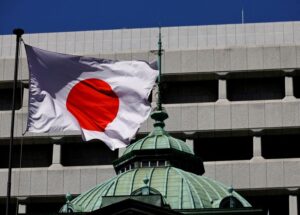Japan yields scale 15-year peaks, bank shares surge as BOJ hikes rates

By Kevin Buckland and Tom Westbrook
TOKYO (Reuters) – Short-term Japanese government bond yields scaled 15-year peaks and Japanese bank shares soared on Wednesday as the Bank of Japan raised interest rates for only the second time since 2007 while announcing a halving of its monthly bond buying.
The two-year JGB yield jumped as much as 8 basis points (bps) to reach 0.45% for the first time since April 2009. The five-year yield added 8 bps to 0.665%, the highest since November 2009.
The Tokyo Stock Exchange’s banking index advanced 4.7%, with big gains for lenders helping the share average to reverse earlier declines.
Exporter shares also recovered after the yen gave up early gains to stabilize around 153 per dollar, following volatile trading in the aftermath of the policy announcement.
The BOJ hiked the key rate target to 0.25% from near zero, and also unveiled a quantitative tightening (QT) plan that would roughly halve monthly bond buying to 3 trillion yen ($19.6 billion), from the current 6 trillion yen, as of early 2026.
In March, the BOJ had ended its negative rate policy and set the overnight call rate as its new policy rate, guiding it in a range of 0-0.1%.
“Given that today’s decision is only four months after the first hike, the market should think the BOJ is perhaps a bit more hawkish than it thought,” said Naka Matsuzawa, chief macro strategist at Nomura.
“The faster-than-expected rate hike makes the case that the BOJ wants to push up short-end yields.”
Investors had been bracing for the change after local media reports overnight said the central bank was mulling such a move, and JGB yields began their climb higher from Wednesday’s open.
The 10-year JGB yield rose as much as 6 bps to 1.055%, although that fell shy of the 13-year peak of 1.1% touched three times over the past two months.
Higher rates promise to improve lending margins and boost investment income, and banking shares were the big beneficiary of the BOJ’s policy decision.
Resona Holdings was the Nikkei’s best performing bank stock with a 6.7% jump, while Mizuho Financial Group gained 5.1% and Sumitomo Mitsui (NYSE:) Financial Group added 4.5%.
The Nikkei ended the day up 1.5% at 39,101.82, reversing earlier declines of as much as 1.5% and recovering the psychologically important 39,000 level for the first time in a week.
The broader finished up 1.5%. A subindex of value shares rallied 1.7%, outpacing a 1.2% rise in growth shares.
Japanese lenders have attracted larger foreign investment flows than other sectors, as investors see them as top beneficiaries of potential monetary tightening.
Banks lured an estimated 472 billion yen of net stock purchases in the year to July 25, according to J.P. Morgan’s quantitative strategy team. That’s more than double the flows into the automobiles and components sector, another top performer.

Most automakers reversed early declines to finish the day higher, but Toyota Motor (NYSE:) was an exception, sagging 1.6% after Japan’s transport ministry issued a corrective order over violations in vehicle certification procedures.
($1 = 152.9900 yen) (This story has been corrected to say that Resona was the best-performing bank stock, not the best-performing stock, in paragraph 12)





